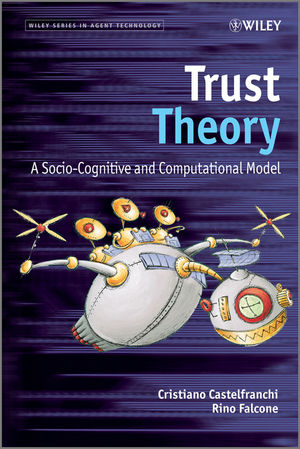Trust Theory: A Socio-Cognitive and Computational ModelISBN: 978-0-470-02875-9
Hardcover
386 pages
May 2010
 |
||||||
Introduction.
1 Definitions of Trust: From Conceptual Components to the General Core.
1.1 A Content Analysis.
1.2 Missed Components and Obscure Links.
1.3 Intentional Action and Lack of Controllability: Relying on What is Beyond Our Power.
1.4 Two Intertwined Notions of Trust: Trust as Attitude vs. Trust as Act.
1.5 A Critique of Some Significant Definitions of Trust.
References.
2 Socio-Cognitive Model of Trust: Basic Ingredients.
2.1 A Five-Part Relation and a Layered Model.
2.2 Trust as Mental Attitude: a Belief-Based and Goal-Based Model.
2.3 Expectations: Their Nature and Cognitive Anatomy.
2.4 ‘No Danger’: Negative or Passive or Defensive Trust.
2.5 Weakening the Belief-Base: Implicit Beliefs, Acceptances, and Trust by-Default.
2.6 From Disposition to Action.
2.7 Can we Decide to Trust?.
2.8 Risk, Investment and Bet.
2.9 Trust and Delegation.
2.10 The Other Parts of the Relation: the Delegated Task and the Context.
2.11 Genuine Social Trust: Trust and Adoption.
2.12 Resuming the Model.
References.
3 Socio-Cognitive Model of Trust: Quantitative Aspects.
3.1 Degrees of Trust: a Principled Quantification of Trust.
3.2 Relationships between Trust in Beliefs and Trust in Action and Delegation.
3.3 A Belief-Based Degree of Trust.
3.4 To Trust or Not to Trust: Degrees of Trust and Decision to Trust.
3.5 Positive Trust is not Enough: a Variable Threshold for Risk Acceptance/Avoidance.
3.6 Generalizing the Trust Decision to a Set of Agents.
3.7 When Trust is Too Few or Too Much.
3.8 Conclusions.
References.
4 The Negative Side: Lack of Trust, Implicit Trust, Mistrust, Doubts and Diffidence.
4.1 From Lack of Trust to Diffidence: Not Simply a Matter of Degree.
4.2 Lack of Trust.
4.3 The Complete Picture.
4.4 In Sum.
4.5 Trust and Fear.
4.6 Implicit and by Default Forms of Trust.
4.7 Insufficient Trust.
4.8 Trust on Credit: The Game of Ignorance.
References.
5 The Affective and Intuitive Forms of Trust: The Confidence We Inspire.
5.1 Two Forms of ‘Evaluation’.
5.2 The Dual Nature of Valence: Cognitive Evaluations Versus Intuitive Appraisal.
5.3 Evaluations.
5.4 Appraisal.
5.5 Relationships Between Appraisal and Evaluation.
5.6 Trust as Feeling.
5.7 Trust Disposition as an Emotion and Trust Action as an Impulse.
5.8 Basing Trust on the Emotions of the Other.
5.9 The Possible Affective Base of ‘Generalized Trust’ and ‘Trust Atmosphere’.
5.10 Layers and Paths.
5.11 Conclusions About Trust and Emotions.
References.
6 Dynamics of Trust.
6.1 Mental Ingredients in Trust Dynamics.
6.2 Experience as an Interpretation Process: Causal Attribution for Trust.
6.3 Changing the Trustee’s Trustworthiness.
6.4 The Dynamics of Reciprocal Trust and Distrust.
6.5 The Diffusion of Trust: Authority, Example, Contagion, Web of Trust.
6.6 Trust Through Transfer and Generalization.
6.7 The Relativity of Trust: Reasons for Trust Crisis.
6.8 Concluding Remarks.
References.
7 Trust, Control and Autonomy: A Dialectic Relationship.
7.1 Trust and Control: A Complex Relationship.
7.2 Adjusting Autonomy and Delegation on the Basis of Trust in Y.
7.3 Conclusions.
References.
8 The Economic Reductionism and Trust (Ir)rationality.
8.1 Irrational Basis for Trust?
8.2 Is Trust an ‘Optimistic’ and Irrational Attitude and Decision?
8.3 Is Trust Just the Subjective Probability of the Favorable Event?
8.4 Trust in Game Theory: from Opportunism to Reciprocity.
8.5 Trust Game: A Procuste’s Bed for Trust Theory.
8.6 Does Trust Presuppose Reciprocity?
8.7 The Varieties of Trust Responsiveness.
8.8 Trusting as Signaling.
8.9 Concluding Remarks.
References.
9 The Glue of Society.
9.1 Why Trust is the ‘Glue of Society’.
9.2 Trust and Social Order.
9.3 How the Action of Trust Acquires the Social Function of Creating Trust.
9.4 From Micro to Macro: a Web of Trust.
9.5 Trust and Contracts.
9.6 Is Trust Based on Norms?
9.7 Trust: The Catalyst of Institutions.
References.
10 On the Trustee’s Side: Trust As Relational Capital.
10.1 Trust and Relational Capital.
10.2 Cognitive Model of Being Trusted.
10.3 Dynamics of Relational Capital.
10.4 From Trust Relational Capital to Reputational Capital.
10.5 Conclusions.
References.
11 A Fuzzy Implementation for the Socio-Cognitive Approach to Trust.
11.1 Using a Fuzzy Approach.
11.2 Scenarios.
11.3 Belief Sources.
11.4 Building Belief Sources.
11.5 Implementation with Nested FCMs.
11.6 Converging and Diverging Belief Sources.
11.7 Homogeneous and Heterogeneous Sources.
11.8 Modeling Beliefs and Sources.
11.9 Overview of the Implementation.
11.10 Description of the Model.
11.11 Running the Model.
11.12 Experimental Setting.
11.13 Learning Mechanisms.
11.14 Contract Nets for Evaluating Agent Trustworthiness.
References.
12 Trust and Technology.
12.1 Main Difference Between Security and Trust.
12.2 Trust Models and Technology.
12.3 Concluding Remarks.
References .
13 Concluding Remarks and Pointers.
13.1 Against Reductionism .
13.2 Neuro-Trust and the Need for a Theoretical Model.
13.3 Trust, Institutions, Politics (Some Pills of Reflection).
References.
Index.



